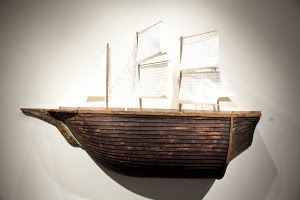Title: MADE IN
Year: 2012
Material: Wood, metal, canvas, ink
Creator: Stephen Hayes
Collection: Collection of the Artist, currently on display at the African American Museum in Philadelphia
Collection: Collection of the Artist, currently on display at the African American Museum in Philadelphia
 |
| MADE IN, 2012 |
 |
| The Brookes Ship, 1789 |
What similarities and differences do you notice? They're both images of boats, yes. One is a diagram, while another appears to be a photograph of a 3-dimensional object. One was created in 1789, the other 223 years later. Removed from their context, it might be a challenge to understand how these images relate (besides being boats), or what they represent. Interpreted within the context of Cash Crop, however, their powerful connection and important message becomes hauntingly clear.
Let's start with the diagram. While conducting image research for a printmaking class at the Savanna College of Art and Design (SCAD), artist Stephen Hayes came across an image diagramming the Brooks Ship, a boat that operated within the transatlantic slave trade from about 1781 to 1806. During its 25 year lifespan, the ship carried over 5000 Africans. This diagram of the ship was published in 1789 by a member of the Society for Effecting the Abolition of the Slave Trade in England. It depicts how the ship was designed to stowe 454 slaves, exactly the legal limit of slaves a ship of its size could transport. Prior to a law enacting this limit in 1788, the Brooks had crammed up to 609 slaves onto its lower decks at a time. You can learn more about the history of the ship, here.
 |
| Hayes' Brooks Diagram |
Having already traveled to institutions in North Carolina and Georgia, the exhibit is currently on display at The African American Museum in Philadelphia. Put simply, Cash Crop examines how people and goods are imported and exported. Not only does the artist look at the Transatlantic slave trade, but also addresses the modern injustices of sweatshops and unfair labor. As the introductory text panels states (in an informal museum voice), the exhibit links “the millions who were transported in slave ships like cargo in years past and the millions today who are confined to factories, like extensions of machines.” Throughout the exhibit, interpretations of the Brooks Ship appear in cement casts, prints and drawings, and etched into a quilt panels made of fiber board.
 |
| The artist with his piece entitled, Gluttony |
 |
Detail of wall of wooden boxes with cast cement ships |
 |
| Detail of MADE IN's sails |
Still, the beautiful curve of the wooden ship, and the gracefulness of its sails can be disarming; at a distance, this object doesn't immediately evoke the realities of sweatshop labor. However, within the context of the exhibit, it is difficult to ignore the darker narrative this vessel, and its sails implies.
 |
| Close-up of figures |
 |
| Hayes' life-sized figures |
Anyone with an interest in contemporary social justice issues such as race, gender, politics, economics, consumerism, poverty, and human trafficking may find MADE IN to be an important and provocative piece. Artistic-minded individuals may also appreciate it as a finely-crafted piece of woodworking.
Viewers strictly interested a historical narrative about the Transatlantic slave trade might not be interested in this MADE IN. Some individuals may not wish to discuss contemporary issues of human trafficking and labor conditions. Perhaps they do not wish to confront their connection to the problem, find the matter too distressing, or may simply be apathetic to issues that they feel are out of their control.
 |
| more info |
In order to better understand “Made In” it might be helpful
to explore international labor laws, as well as the history of cash crops. One could learn more about human trafficking through CNN's The Freedom Project or through books like Human Trafficking Around the World: Hidden in Plain Sight, by investigative journalist Stephanie Hepburn.
It would also be interesting to learn about the ways the
Brooks (or Brookes, as it is spelled in the UK) Ship has been interpreted by
other artists. The live recreation pictured in the photo below, which took
place at the York Castle Museum. Pretty intense, right? Read more about it, and
other related exhibits, here.
 |
| Recreation at the York Castle Museum |
 |
| Anti-Slavery Broadside |
I challenge you to do your own research--where and by whom are your clothes made? Are there people being harmed or exploited in one or more steps along the process? Are there changes you can and should make as a consumer to support a more just system of supply and demand?
No comments:
Post a Comment